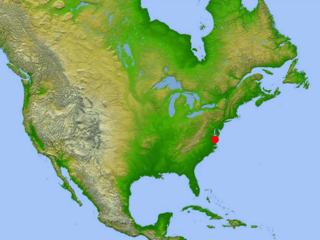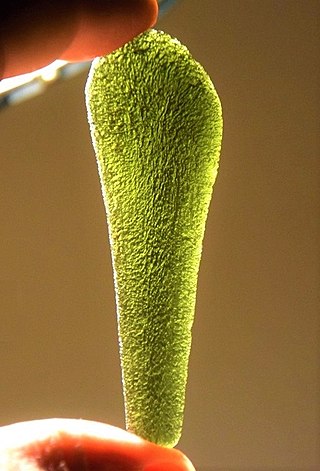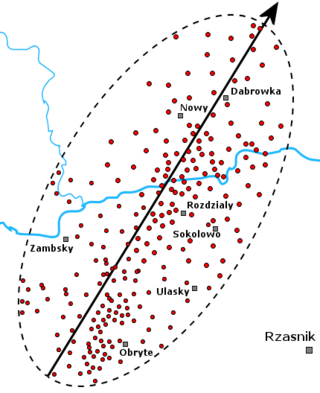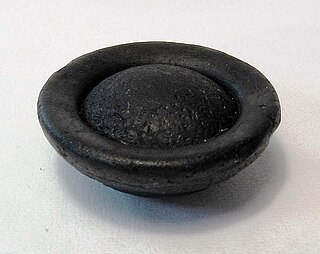
Tektites are gravel-sized bodies composed of black, green, brown or grey natural glass formed from terrestrial debris ejected during meteorite impacts. The term was coined by Austrian geologist Franz Eduard Suess (1867–1941), son of Eduard Suess. They generally range in size from millimetres to centimetres. Millimetre-scale tektites are known as microtektites.

The Chesapeake Bay impact crater is a buried impact crater, located beneath the mouth of Chesapeake Bay, United States. It was formed by a bolide that struck the eastern shore of North America about 35.5 ± 0.3 million years ago, in the late Eocene epoch. It is one of the best-preserved "wet-target" impact craters in the world.

Impactite is rock created or modified by one or more impacts of a meteorite. Impactites are considered metamorphic rock, because their source materials were modified by the heat and pressure of the impact. On Earth, impactites consist primarily of modified terrestrial material, sometimes with pieces of the original meteorite.

Lechatelierite is silica glass, amorphous SiO2, non-crystalline mineraloid.

Underwater habitats are underwater structures in which people can live for extended periods and carry out most of the basic human functions of a 24-hour day, such as working, resting, eating, attending to personal hygiene, and sleeping. In this context, 'habitat' is generally used in a narrow sense to mean the interior and immediate exterior of the structure and its fixtures, but not its surrounding marine environment. Most early underwater habitats lacked regenerative systems for air, water, food, electricity, and other resources. However, some underwater habitats allow for these resources to be delivered using pipes, or generated within the habitat, rather than manually delivered.
John Aloysius O'Keefe III (1916–2000) was an expert in planetary science and astrogeology with the National Aeronautics and Space Administration (NASA) from 1958 to 1995.

Moldavite is a forest green, olive green or blue greenish vitreous silica projectile glass formed by a meteorite impact in southern Germany that occurred about 15 million years ago. It is a type of tektite and a gemstone.

Mitch Shelley, also known as Resurrection Man, is a character appearing in stories published by DC Comics. The character was created by Andy Lanning, Dan Abnett, and Jackson Guice, and first appeared in Resurrection Man #1 in 1997. The character does not identify himself as a superhero but often involves himself in cases where he protects people from criminals and super-villains. Due to sub-atomic technology in his bloodstream, Shelley cannot be permanently killed. No matter how he is killed or how much damage is done, he always resurrects fully healed. With each resurrection, he also has a different additional new super-power. In some cases, there is a physical transformation element to his resurrection.

Bediasite is a form or type of tektite, which is a body of natural glass formed from earth debris during meteorite impact events. It originates in an area in the eastern part of the U.S. state of Texas centered on the small town of Bedias which is 74 miles (119 km) north west of Houston. They are found in about nine Texas Counties in an area of over 7,000 square miles (18,000 km2). The largest specimen ever found is just over 200 grams.

Georgiaite is a rare form of tektite found only in the state of Georgia in the southeastern United States. These tektites are found in part of the North American strewn field coming from what is believed to be the Chesapeake Bay impact crater in the late Eocene epoch over 35 million years ago. Two strewn fields and tektite groups are currently associated with this impact: the black bediasites in Texas and the green georgiaites in Georgia.

The Tektite habitat was an underwater laboratory which was the home to divers during Tektite I and II programs. The Tektite program was the first scientists-in-the-sea program sponsored nationally. The habitat capsule was placed in Great Lameshur Bay, Saint John, U.S. Virgin Islands in 1969 and again in 1970.
Pantasma is a region in the north of Nicaragua. In the Miskito language the word Pantasma means small humans or flat head. The Spanish word Fantasma origins from the Greek Phantasma and means ghost.

The Australasian strewnfield is the youngest and largest of the tektite strewnfields, with recent estimates suggesting it might cover 10%–30% of the Earth's surface. Research indicates that the impact forming the tektites occurred around 788,000 years ago, most likely in Southeast Asia.
Edward Ching-Te Chao was one of the founders of the field of impact metamorphism, the study of the effects of meteorite impacts on the Earth's crust.

The term strewn field indicates the area where meteorites from a single fall are dispersed. It is also often used for the area containing tektites produced by large meteorite impact.
Vitrified sand is sand that has been heated to a high enough temperature to undergo vitrification, which is the melting of the silicon dioxide or quartz that compose common sand. Vitrified sand is a type of natural glass, contrasted with manufactured glass in which soda ash or potash are added to lower the melting point. Pure quartz melts at 1,650 °C (3,002 °F). There are several natural processes that produce more or less melted sand and one man-made form:

Australites are tektites found in Australia. They are mostly dark or black, and have shapes including discs and bowls that are not seen in other tektites. NASA used the shape of "flanged button" australites in designing re-entry modules for the Apollo program in the 1960s.
Bruce Baden Collette is an American ichthyologist.

Philippinites, or rizalites are tektites found in the Philippines. They are considered to be about 710,000 years old on the average and generally ranging in size from millimeters to centimeters. Their age corresponds with the age of other tektites in the Australian strewn tektite field. In 1964, a very large philippinite, weighing 226.3 grams with dimensions 6.5 x 6.2 x 5.2 cm, was purchased by the University of California, Los Angeles Department of Astronomy. The heaviest philippinite ever found weighs 1,281.89 grams in its splash-form, which is also the heaviest tektite of this kind.
Dinosaurs: The Final Day with David Attenborough is a British documentary programme that aired on BBC One on 15 April 2022. Presented by David Attenborough, the documentary follows the final days of non-avian dinosaurs through the Cretaceous–Paleogene extinction event, similar to BBC's Prehistoric Planet. Like that series, the programme's creatures were also made with computer-generated imagery.














